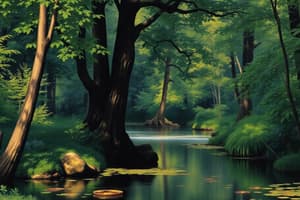Podcast
Questions and Answers
What is the aim of the experiment described in the content?
What is the aim of the experiment described in the content?
- To compare the growth of seedlings with and without mica barriers
- To study the movement of auxin in coleoptiles exposed to unidirectional lighting (correct)
- To investigate the effect of gelatine on seedling growth
- To observe the growth of seedlings in different lighting conditions
Seedling C grows in the direction of the light source.
Seedling C grows in the direction of the light source.
False (B)
What is the purpose of using a mica barrier in the experiment?
What is the purpose of using a mica barrier in the experiment?
To block the movement of auxin
The three seedlings are placed in a cardboard box with a _______________ on one side.
The three seedlings are placed in a cardboard box with a _______________ on one side.
What is the difference between Seedling A and Seedling B?
What is the difference between Seedling A and Seedling B?
The seedlings should be of different plant species.
The seedlings should be of different plant species.
What is the purpose of removing the tip of the shoot in Seedling C?
What is the purpose of removing the tip of the shoot in Seedling C?
The seedlings are left in the same environmental conditions for the same amount of _______________.
The seedlings are left in the same environmental conditions for the same amount of _______________.
Match the following seedlings with their characteristics:
Match the following seedlings with their characteristics:
What is the implication of the growth pattern of Seedling A?
What is the implication of the growth pattern of Seedling A?
Flashcards are hidden until you start studying
Study Notes
Ecosystems
- An ecosystem consists of the organisms in a given area and their interactions with the biotic and abiotic components of that area.
- Biotic components include living organisms, while abiotic components include physical and climatic characteristics of the environment.
Components of an Ecosystem
- Habitat: the natural environment in which an organism or species normally lives or occurs.
- Population: a group of individuals of the same species living in a specific geographic area.
- Community: a group of different species living in a specific geographic area.
- Niche: the role and position of a species within its environment.
- Intraspecific competition: competition between individuals of the same species for limited resources.
- Interspecific competition: competition between individuals of different species for limited resources.
Maltese Ecosystems
- Woodland ecosystem: characterized by high water availability and deep soil, with vegetation consisting of trees, shrubs, and climbing plants.
- Maquis ecosystem: characterized by shallow soil and low water availability, with vegetation consisting of shrubby, evergreen plants.
- Garigue ecosystem: characterized by shallow pockets of soil in cracks and depressions between rocks, with vegetation consisting of aromatic plants that are adapted to survive dry conditions.
- Freshwater ecosystem: characterized by temporary rainwater pools and streams, with vegetation consisting of deciduous trees and aquatic plants.
Interactions between Biotic Components
- Predator: an organism that hunts and feeds on other organisms.
- Prey: an organism that is hunted and fed upon by a predator.
- Intraspecific competition: competition between individuals of the same species for limited resources.
- Interspecific competition: competition between individuals of different species for limited resources.
- Parasitism: a relationship in which one organism (the parasite) benefits from another organism (the host) without harming it.
- Mutualism: a relationship in which both organisms benefit from each other.
Plant Tropism
- Tropism: the growth response of a plant to a stimulus, such as light or gravity.
- Phototropism: the growth response of a plant to light.
- Geotropism: the growth response of a plant to gravity.
- Auxins: plant hormones that promote cell elongation and differentiation.
Representing Ecosystems
- Producer: an organism that produces its own food through photosynthesis.
- Consumer: an organism that obtains energy by consuming other organisms.
- Food chain: a series of organisms that eat other organisms, with energy flowing from one level to the next.
- Food web: a network of food chains that are interconnected.
- Pyramid of numbers: a graphical representation of the number of organisms at each trophic level.
- Pyramid of biomass: a graphical representation of the total biomass at each trophic level.
- Pyramid of energy: a graphical representation of the energy available at each trophic level.
Closed Systems and Carrying Capacity
- Closed system: a system that does not exchange matter with its surroundings.
- Carrying capacity: the maximum number of organisms that an ecosystem can support indefinitely.
- The planet cannot support unlimited growth of a population because resources are limited.
Studying That Suits You
Use AI to generate personalized quizzes and flashcards to suit your learning preferences.




